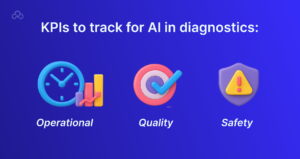Introduction

Clinicians don’t need another shiny demo; they need fewer misses, faster turnaround, and documentation that holds up during audits. That’s the promise of AI in diagnostics and diagnostic technology when it’s implemented as part of everyday workflow, not a sidecar project. Done right, AI in medicine increases sensitivity at stable specificity, reduces inter-reader variance, and shortens time-to-treatment, without burying teams in alerts. The point isn’t “autopilot,” it’s assistive intelligence inside healthcare automation that is observable, measurable, and reversible if something drifts. It’s not perfect automated healthcare. But closer.
High-impact clinical use cases for AI in diagnostics (and what actually changes)
Radiology. Triage models push suspected criticals (e.g., pneumothorax, intracranial bleed) to the top of the worklist; drafting bots pre-fill structured impressions; post-read QC flags contradictions (“no effusion” in findings vs “large effusion” in impression).
Case snapshot: After enabling triage, a chest X-ray service cut median time-to-first-read for flagged cases while keeping sensitivity stable at a fixed specificity threshold. Queue volatility went down; re-reads went down too.
Pathology. Whole-slide image quality checks catch out-of-focus regions; region-of-interest pre-screening narrows gigapixel canvases to minutes not hours; mitotic count assistance increases consistency for junior readers.
Case snapshot: A benign-heavy pipeline reduced manual full-slide reviews by routing likely benign to a “fast lane,” with senior over-read still in loop.
Cardiology & ED. ECG anomaly screening and echo quantification assistance add a second set of eyes; early-warning sepsis signals highlight deteriorations in vitals and labs before they look obvious.
Case snapshot: Enabling a sepsis early-warning bot opened a wider antibiotics window. ICU transfers per 1,000 ED visits trended lower in the next quarter (correlation ≠ causation, teams validated cautiously).
Dermatology & Ophthalmology. Risk scoring for skin lesions and DR grading queues help standardize “who needs the next slot” decisions.
Across all of this, the human stays in the loop. Diagnostic technology is positioned as a second reader or quality gate, never as final authority. That’s essential in automated healthcare where accountability must remain traceable.
Data foundations & evaluation in AI in diagnostics (get this wrong, everything wobbles)
Data first. Labeling protocols, consensus reads, and adjudication remove noise; prevalence realism keeps models honest; subgroup balancing prevents performance cliffs on under-represented cohorts. Privacy is non-negotiable: de-identification, PHI minimization, and audit trails sit under automated healthcare like a floor.
Metrics next. AUROC is fine, but for imbalanced diagnostic tasks, AUPRC plus calibrated PPV/NPV at clinically chosen thresholds matters more. Capture sensitivity/specificity at those thresholds, not just at the Youden index. Track Expected Calibration Error (ECE) and plot reliability curves, poor calibration turns “confident” wrong predictions into operational risk.
Study design. Sequence it: (1) retrospective external validation on out-of-distribution sites; (2) prospective silent mode to measure alert burden and false-positive rates in situ; (3) limited enablement with reader study and pre-declared acceptance bands. Thresholds are clinical decisions, not just math, because false negatives hurt.
Workflow integration & safety (where bots live day-to-day)Integration patterns.
1. Pre-read triage: Reorders the worklist; criticals bubble up.
2. Concurrent second reader: Flags regions and terms during the read, within PACS or viewer.
3. Post-read quality gate: Cross-checks contradictions and missing required fields.
4. Report copilot: Drafts structured text that the clinician edits and signs.
Interfaces & infrastructure. Most teams insert AI in diagnostics directly into PACS via plug-ins, or surface it in EHR via SMART on FHIR side panels. Edge inference (on device or on-prem) reduces latency and data egress; cloud adds burst capacity and MLOps velocity. Not all sites need cloud first; data gravity is real.
Safety, governance, compliance. Treat models like SaMD: hazard analysis, mitigations, post-market surveillance. Pin versions; document change control; log overrides with rationale (short, human readable). Monitor drift (input distribution, calibration, subgroup deltas). Handle alert fatigue by capping alert volume per study and allowing gated escalation. PHI handling: least privilege, role-based access, full audit trail. If something looks off, roll back. Fast. It’s okay to be wrong, not okay to be quietly wrong.
Use the matrix below to map each AI in diagnostics integration pattern to its clinical goal, human-in-the-loop touchpoint, key risks, safety mitigations, and KPIs, so the workflow behaves predictably inside real automated healthcare.
|
Integration pattern |
Where it lives |
Clinical goal |
Human-in-the-loop point |
Primary risks |
Safety mitigations (practical) |
Example KPIs to track |
|
Pre-read triage |
PACS worklist / viewer plug-in |
Surface suspected criticals first (e.g., pneumothorax, ICH) to cut time-to-first-read |
Clinician reviews flagged studies first; flags are advisory, not final |
Missed positives if threshold too high; alert overload; shift bias toward flagged only |
Conservative thresholds with weekly review; per-study alert caps; “unflagged-but-urgent” sampling checks; version pin + rollback plan |
Median & P90 time-to-first-read (flagged); sensitivity at fixed specificity; alert acceptance rate; queue depth variance |
|
Concurrent second reader |
PACS overlay / CAD panel |
Real-time guidance: regions of interest, key terms while reading |
Reader remains primary; can toggle overlays; accepts/rejects suggestions |
Alert fatigue; anchoring bias; UI distraction |
Relevance filters; max N hints per study; hotkey to hide/show; log accepts/rejects + rationale |
Reader time per case; accepted-hint rate; false-positive hint rate; first-pass read rate |
|
Post-read quality gate (QC) |
Report editor / LIS check |
Catch contradictions, missing required fields, templating errors before sign-off |
Clinician reviews “soft-stop” warnings and resolves or overrides with reason |
Over-blocking (workflow friction); warning blindness |
Soft-stop (not hard) with reason codes; whitelist common patterns; periodic rules tuning; escalation only for safety-critical mismatches |
Contradiction rate; addenda rate post-go-live; override rate + top reasons; report return-for-edit rate |
|
Report copilot (drafting) |
Report editor / EHR note composer (SMART on FHIR) |
Faster, more consistent structured text grounded to images/findings |
Human edits every line; mandatory sign-off; banned-phrase lexicon |
Hallucination; drifted templates; leakage of uncertain language |
Constrained templates; retrieval-grounding (PACS/EHR context); banned-phrase list; change control on templates; audit trail of edits |
Documentation time per study; keystrokes saved; edit distance vs draft; clinician satisfaction; incident count (language errors) |
ROI & KPIs you can defend (and trend every week)
Economics. Costs: licensing, integration, validation, monitoring. Benefits: throughput gains, rework reduction, fewer escalations, avoided adverse events. The model is simple: time saved × cost of time + downstream avoidance. Yes, it’s approximate; still useful.
KPIs to track for AI in diagnostics:

1. Operational: study turnaround time (median and P90), queue depth variance, first-pass read rate, escalation delay.
2. Quality: sensitivity/specificity at fixed clinical thresholds; PPV/NPV by subgroup; calibration drift (ECE).
3. Safety: alert acceptance, override rate with reasons, near-miss and incident counts post-enablement.
Reporting cadence. Weekly trend by modality and patient subgroup; anomalies trigger root-cause: data shift? reader behavior? version change? Keep the KPI set small, stable, and mapped to decisions. If your dashboard doesn’t change actions, it’s just wall art.
Where to start next
Pick one workload where AI in diagnostics is mature (e.g., CXR triage, DR grading). Embed a single diagnostic technology pattern (pre-read triage or post-read QC). Define three KPIs. Ship to silent mode in two weeks, limited mode in six. Small, boring wins beat grand unveilings, especially in automated healthcare where safety and trust compound. It isn’t magic; it’s disciplined AI in medicine and AI in diagnostics joined to everyday clinical practice.
Technical FAQs
AUROC or AUPRC for imbalanced tasks?
Use AUPRC, plus calibrated PPV/NPV at the threshold clinicians actually accept. AUROC alone can look great while missing rare positives. Not good.
How do we prove generalization across sites?
External validation with matched case-mix, predefined acceptance bands, and a prospective silent run. If subgroup KPIs diverge, pause and re-calibrate before enablement.
Safest way to introduce AI in medicine bots into PACS/EHR?
Start in silent mode, then gated alerts. Capture overrides with reason codes; cap alert volume; review weekly until alert burden is stable. Don’t rush this part.
How is model drift detected and fixed?
Monitor input distributions, calibration error, and subgroup deltas. When drift is significant, re-calibrate or retrain; use version pins and a rollback playbook. Document everything.
Edge vs cloud for inference in automated healthcare?
Edge lowers latency and keeps PHI local; cloud scales elastically and speeds MLOps. Many hospitals run hybrid. Pick based on data gravity and required response times.
Do you like to read more educational content? Read our blogs at Cloudastra Technologies or contact us for business enquiry at Cloudastra Contact Us.